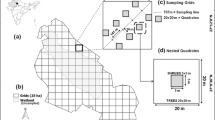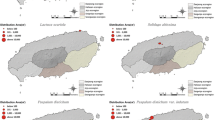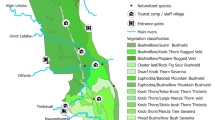Abstract
The rubber vine (Cryptostegia grandiflora) is an aggressive, invasive weed species with a high spreading potential that has caused great ecological impacts and economic costs to the areas in which it has been introduced. In Mexico, there is little information on the invasion of this species. In Baja California Sur (BCS), the first record of the species is documented from 1935 in one oasis. Despite the ecological problems that this invasive species may cause in the oases of BCS, little was known about its distribution and status. The aim of this work was to document the presence of the rubber vine in 57 oases in Baja California Sur during 2006–2008. The rubber vine was present in 22 (39%) of the sampled oases. The distribution pattern strongly suggests that the rubber vine had been introduced by the local population and then spread in the oasis and into the vicinity of streams and canyons. Vertebrate and invertebrate endemic oasis-dependent species may be at risk because the rubber vine can become a dominant species in oases and because reptiles and birds may not use the plant and instead avoid the areas where it grows. This is risky in fragile ecosystems immersed in a desert. Education and eradication of rubber vines from oases should be urgently done.
Similar content being viewed by others
Abbreviations
- BCS:
-
The state of Baja California Sur
References
Andreu J, Vilà M (2010) Risk analysis of potential invasive plants in Spain. J Nature Conserv 18:34–44. doi:10.1016/j.jnc.2009.02.002.A
Arriaga L, Rodríguez-Estrella R (1997) Los Oasis de la Península de Baja California. Publ 13. CIBNOR. La Paz, Baja California Sur, México
Bengsen AJ, Pearson RG (2006) Examination of factors potentially affecting riparian bird assemblages in a tropical Queensland savanna. Ecol Manag Restor 7:141–144
Cavalcante A, Major I (2006) Invasion of alien plants in the Caatinga biome. Ambio 35:141–143
Grice AC (1996) Seed production, dispersal and germination in Cryptostegia grandiflora and Ziziphus mauritiana, two invasive shrubs in tropical woodlands of northern Australia. Australian J Ecol 21:324–331
Grismer LL (2002) Amphibians and Reptiles of Baja California. Including its Pacific Islands and the Islands of the Sea of Cortes. University of California Press, Berkeley
Grismer LL, McGuire JA (1993) The oases of central Baja California, Mexico. Part 1. A preliminary account of the relict mesophilic herpetofauna and the status of oases. Bull South Calif Acad Sci 92:2–24
Howard RA, Powell DA (1963) The introduction of rubber-producing species in the West Indies. Econ Bot 17:337–349
Humphries SE, Groves RH, Mitchell DS (1991) Plant invasions of Australian ecosystems. Status review and management directions. Kowar 12:1–127
Jiménez-Jiménez ML, Llinas J (2005) Especie nueva de Oecobius (Araneae:Oecobiidae) de Baja California, México. Rev Mex Biodivers 76:46–48
Jiménez-Jiménez ML, Palacios-Cardiel C (2010) Scorpions of desert oases in the southern Baja California Peninsula. J Arid Environ 74:70–74
Klackenberg J (2001) Revision of the genus Cryptostegia R. Br. (Apocynaceae, Periplocoideae). Adansonia sér. 3(23):205–218
Kriticos DJ, Sutherst RW, Brown JR et al (2003) Climate change and biotic invasions: a case history of a tropical woody vine. Biol Invasions 5:147–165
Luja V, Rodríguez-Estrella R (2010) The invasive bullfrog Lithobates catesbeianus in oases of Baja California Sur, Mexico: potential effects in a fragile ecosystem. Biol Invasions (in press). doi: 10.1007/s10530-010-9713-z
McFadyen RE, Harvey GJ (1990) Distribution and control of rubber vine Cryptostegia grandiflora a major weed in northern Queensland Australia. Plant Prot Q 5:152–156
Pimentel D, Zuniga R, Morrison D (2005) Update on the environmental and economic costs associated with alien-invasive species in the United States. Ecol Econ 52:273–288
Radford IJ (2003) Demography, fecundity and natural enemy dynamics of rubber vine (Cryptostegia grandiflora) in riparian and upland sites of north Queensland. Plant Prot Q 18:138–142
Recuero E, Martínez-Solano I, Parra-Olea G et al (2006) Phylogeography of Pseudacris regilla (Anura: Hylidae) in western North America, with a proposal for a new taxonomic rearrangement. Mol Phylog Evol 39:293–304
REMIB (2009) Red Mundial de Información sobre Biodiversidad-Data base, Nodes: XAL, IEB, USON, HCIB, BCMEX, ARIZ, CICY, IZTA (http://www.conabio.gob.mx/remib/cgi-bin/clave_remib.cgi?lengua=EN)
Roberts NC (1989) Baja California plant field guide. Natural History, USA
Rodríguez-Estrella R, Blázquez MC, Lobato JM (2005) Avian Communities of Arroyos and Desert Oases in Baja California Sur: Implications for conservation. In: Cartron J-LE, Ceballos G, Felger RS (eds) Biodiversity and conservation North Mexico Book. Oxford University Press, pp 334-353
Rodríguez-Estrella R, Rubio L, Pineda E, Blanco G (1999) The Belding’s Yellowthroat: current status, habitat preferences, and threats in oases of Baja California, Mexico. Anim Conserv 2:77–84
Rodríguez-Estrella R, R-Fernández RC, Blázquez MC et al (2006) Estudio previo justificativo para el establecimiento del área natural protegida con la categoría de Área de Protección de Flora y Fauna Oasis de Baja California Sur conformada en Archipiélago. Comisión Nacional de Áreas Naturales Protegidas—SEMARNAT. México
Ruiz-Campos G, Camarena-Rosales F, Contreras-Balderas S et al (2006) Distribution and abundance of the endangered killifish Fundulus lima, and its interaction with exotic fishes in oases of central Baja California, Mexico. Southwest Nat 51:502–509
Sakai AK, Allendorf FW, Holt JS et al (2001) The population biology of invasive species. Annu Rev Ecol Syst 32:305–332
Tomley AJ (1995) The biology of Australian weeds 26. Cryptostegia grandiflora R. Br. Plant Prot Q 10:122–130
Valentine LE, Roberts B, Schwarzkopf L (2007) Mechanisms driving avoidance of non-native plants by lizards. J Applied Ecol 44:228–237
Wiggins IL (1980) Flora of Baja California. Stanford University Press, Stanford
Acknowledgments
Thanks to A. Cota and F. Cota for field assistance. Thanks to all ranchers and local people of the oases. Financial support from SEP-CONACyT (SEPC01-45737) and SEMARNAT-CONACyT (0000023861) was provided to RRE for this study. RRE also received a sabbatical grant in the EBD, Spain during the writing of this ms. Thanks to Dr. Ellis Glazier for editing this English-language text.
Author information
Authors and Affiliations
Corresponding author
Rights and permissions
About this article
Cite this article
Rodríguez-Estrella, R., Navarro, J.J.P., Granados, B. et al. The distribution of an invasive plant in a fragile ecosystem: the rubber vine (Cryptostegia grandiflora) in oases of the Baja California peninsula. Biol Invasions 12, 3389–3393 (2010). https://doi.org/10.1007/s10530-010-9758-z
Received:
Accepted:
Published:
Issue Date:
DOI: https://doi.org/10.1007/s10530-010-9758-z




